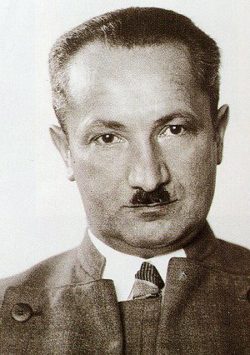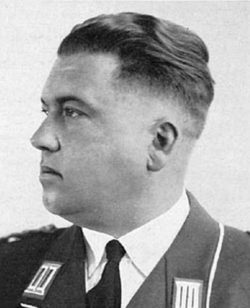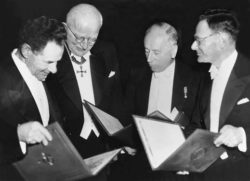Staudinger’s own plan to develop the government research institute of macromolecular chemistry into a federal institute “in line with its importance for the modern chemical industry and to broaden its financial basis” (Klaar 1953) came to nothing due to a lack of support. When Staudinger resigned from the position of head of the institute as agreed in 1956, the Baden-Württemberg Ministry of Education established an extraordinary professorship for macromolecular chemistry – the university institute of macromolecular chemistry was set up and then, in 1962, moved to a new building that is known today as “Hermann-Staudinger-Haus” (cf. Magda Staudinger 1987, 22).
On 23. March 1956, Staudinger’s 75th birthday, Albert Ludwigs University in Freiburg held an official ceremony, at which Staudinger was honoured in appropriate fashion as he retired from his position as honorary head of the institute. The university rector, Bernhard Welte (1908-1983), a philosophy of religion professor, spoke at the ceremony:
“Thirty years ago now, you created an opening in the dark wall of nature, which science is constantly trying to illuminate and penetrate. [...] Today, the opening is so large that an entire world has gone through it – and is still going through it. The entire world of industry, of fibres and plastics, spread throughout all the countries of the earth, without which our lives today would no longer be conceivable, and the entire world of all those who use these fibres and plastics of many different kinds. [...] A huge new field of science, business and life has developed behind the opening that you made [...] with your scientific work!” (quoted in Staudinger 1961, 305).
Asked about his plans for the future just after he won the Nobel Prize, Staudinger had already revealed his intention to start studying botany again – the subject that he gave up in favour of chemisty when he was a young man (see Part 1 of this series): “He studied chemistry because this was the basic science that preceded botany. >Now [...] the time has come to start studying botany.< The Nobel Prize winner [...] plans to be become a student. That’s the way it is – you never stop learning.” (Kunze 1953) Magda Staudinger 1987, 10 says: “When he was quite old, he used to say that he did not know enough chemistry yet to start studying botany. In response to this, the dean of his faculty in Freiburg said at a small ceremony in connection with the presentation of the Nobel Prize in 1953 that the faculty now – after this event – expected the would-be botany student to take his exams in this subject at long last!” There is a realistic background to what sounds just like an anecdote: Staudinger’s return to botany illuminated the origins of his macromolecule theory, on the one hand, while it opened up a new area of research – molecular biology – to him at the same time. This interface makes it clear just how stimulating Staudinger must have found his encounter with the botanist Dr. phil. Mag. rer. nat. Magda Woit, who became his wife when he married for the second time in 1928, at the scientific level too. Staudinger got to know the daughter of the Latvian ambassador, who came from Riga, on Helgoland in August 1927. Magda Staudinger 1987, 17-18, remembers this as follows:
“I studied [...] in Berlin, because my father was the first ambassador of the state of Latvia in Berlin in the 20s after the country became independent. I obtained my doctorate there in 1925 with the plant physiologist Gottfried Haberlandt (1854-1945, editor’s note); I then returned to Riga, took the state examination at Riga University and became an assistant to Nicolai Malta in the botanical laboratory. I was particularly interested in marine algae and I was delighted when I was given a job as a guest at the biological institute on Helgoland in the summer of 1927. I was interested in the cell membrane of the algae and I tackled my experiments with the equipment and know-how about colloidal substances that were available at the time. The Freiburg botanist Friedrich Oltmanns (1860-1945, editor’s note), who was an algae specialist, came to Helgoland in August too. I had got to know him by taking two algae courses with him while I was still a student. One day, he was standing on the jetty in Helgoland with another gentleman and spoke to me as I walked by. He introduced the other gentleman to me: >My colleague from the chemistry department, Hermann Staudinger< and, turning to Staudinger, he mentioned that I was working on cell membranes of algae at the biological institute. Hermann Staudinger was interested to hear this and asked if he could take a look at my experiments: he had just published a paper about a model for cellulose, the main component of plant cell membrane. That in turn interested me and we arranged that he would visit the laboratory. He came on 24. August, took a look at my experiments and had me explain them. Suddenly, he then said to my amazement: >It is all completely different<, sat down on a laboratory stool and started to talk: >There are macromolecules and they will be tremendously important to biology in future, because living cells can only be constructed with such large molecules. Thanks to their size, they have different shapes; the different structures that the living cell needs are possible as a result. Thanks to their size, they can – in turn – accommodate very different reactive groups.< He talked about these things for quite a while and explained phenomena that were in some cases only demonstrated at the experimental level many years later. On the basis of his cellulose model and stimulated in his thinking by my experiments, the role played by macromolecules in biological processes occurred to him there and then at this time on 24. August 1927. It was like a vision to him. Molecular biology now exists today and is very successful. The name does not come from us; it was used first by the English chemist (William Thomas, editor’s note) Astbury (1898-1961) around 1945. The first conversation about these ideas took place back then on Helgoland, however. In my opinion, this is therefore when molecular biology first began.”
In view of this, Jaenicke 2003, 604, was accurate in describing Magda Staudinger as “the moira who helped to spin the macromolecular threads”. The couple did not carry out systematic “experimental trials on living cell substances” until after 1945, however, due – among other things – “to the destruction of the institute during the war” (Magda Staudinger 1987, 18). The direction was clear, however, the vision stayed alive and there was tremendous general interest outside the scientific community too, as the reports in the daily press in the context of the presentation of the Nobel Prize to Staudinger show: “Macromolecular chemistry is [...] likely to be of the greatest importance to biology and medicine. It is definite that life processes are associated inseparably with macromolecules. Chemically speaking, life consists of the formation, conversion, dissolution and also reproduction of macromolecules that follow the laws of life – this is how the “Lindauer Zeitung” put it (Hahn 1953; cf. Staudinger 1938, 24, 25 and 29 as well as Staudinger 1961, 302, 306-307 and 333-334). “All our modern plastics are [...] large molecules. But all living substances are macromolecular too. Staudinger’s theory will therefore be celebrating its greatest triumphs in the biological field”, wrote “Die Welt” (Theimer 1953). Expectations that have been met: “Current thinking in the molecular biology field is inconceivable without the macromolecular concept. Genetic science, which is developing rapidly today, is also based on the macromolecular principles proposed by Hermann Staudinger.” (Jostkleigrewe 1987, 7; cf. Rothschuh 1963, 135-136).
Staudinger already had an excellent international reputation too, even before he won the Nobel Prize, and he was in demand as a speaker outside Germany as well. In November 1950, for example, he was invited to Rome to speak at the Centro Romano di Studi. The Staudingers took this opportunity to attend a private audience with Pope Pius XII at St. Peter’s Basilica (Magda Staudinger 1987, 23).
However, it was no longer possible to ignore the fact that Staudinger, who once led the avant-garde in the organic chemistry field, now held mainstream positions that were no longer in tune with the times in all cases. Staudinger was in danger of being overtaken by scientific progress or even of being left behind. Where new findings conflicted with his own views, he classified them as improper attacks, ignored them or fought a losing battle against them. He did not accept the physical-chemical proof of the flexibility of linear macromolecules, for example, and stubbornly maintained his concept of macromolecules as rigid, rod-like structures. He was just as unwilling to accept modifications to his law about the relationship between molecule size and viscosity:
“On the basis of the assumption that linear macromolecules can also exist as clusters, Hermann Mark (1895-1992, editor’s note) co-operated with the Dutch physical chemist Roelof Houwink (1899-1987, editor’s note) in Vienna to continue empirical development of Staudinger’s viscosity equation (Mark-Houwink equation). [...] The corrections / additions to Staudinger’s viscosity law made by Mark and Houwink proved to be correct, but they were still being rejected by Staudinger in the 1950s too.” (Deichmann 2000, 410)
Staudinger lagged behind polymer science in the United States in particular. Here, at the Polytechnic Institute of New York in Brooklyn, was where Hermann Mark worked, the man with whom Staudinger had held a fierce dispute from 1926 onwards (see Part 2 of this series). Mark fled to the USA in 1938 to get away from the Nazis, after he lost his licence to teach at Vienna University because he was a Jew and was put in prison for a while. Helmut Ringsdorf (born in 1929, editor’s note) – one of Staudinger’s undergraduate and doctoral students – worked at Mark’s institute in Brooklyn from the end of the Fifties onwards as a post-doctoral student. Staudinger did not do well in a comparison of the “two worlds”:
According to Ringsdorf, “the Freiburg Institute was no longer the world leader in the polymer field in the 50s. Although the work done there was sound, it was generally classical. As the head of the institute, Hermann Staudinger definitely continued to focus too much on the virulent and tough battles he had fought in the 1920s. Hermann Mark, on the other hand, had activated macromolecular chemistry on a broad basis in the USA after the war. He brought physicists, chemists and technologists together and developed a modern version of polymer science as a result. This gave the institute in Brooklyn the prominent international position it held at the time. This development took somewhat longer at Staudinger’s institute [...]. I only learned in Brooklyn what new developments were going on in polymer chemistry.” (quoted in Deichmann 2001, 150)
The two worlds then collided in 1957: Staudinger accepted an invitation to Brooklyn that Marks issued to him to give a lecture there. He was received “as the polymer pioneer, as the person >who led the polymer crusade<” (Deichmann 2001, 186). Staudinger did not make a good impression, however. Ringsdorf remembers:
“I arranged the slides for Staudinger’s lectures back then and so I knew what he was going to talk about. Compared with what was being done in Brooklyn at the time, it has to be said that these lectures almost represented the dark ages of polymer science. I can make this statement particularly emphatically, because I still have the original slides [...] of the last four lectures. The young people in Brooklyn in particular certainly admired and revered Hermann Staudinger at this time as the grand old man of macromolecular chemistry. They were probably forgiving about what he said, particularly in view of the fact that he spoke in German.” (quoted in Deichmann 2001, 186-187; cf. Magda Staudinger 1987, 25)
1957 was also the year when Staudinger gave guest lectures in Japan too. This was the country where his early writings about high-molecular organic compounds were still revered as if they were the Bible (see Magda Staudinger 1987, 20). During this stay, Staudinger met the Tenno, the Japanese emperor (ibid., 20 and 26). In 1958, Staudinger headed the German delegation at the international “Science House” at the World Fair in Brussels. He continued to receive honours as well: Staudinger was awarded the Grand Order of Merit of the Federal Republic of Germany another two times, in 1957 with Star and in 1965 with Star and Sash (Source).
“He had good fortune that only a few scientists share: being able to experience and enjoy all the success of his work”, Krüll 1978a, 49, writes about Staudinger’s retirement. His health deteriorated, however; Staudinger had heart problems (Mark 1966, 93). “His intellect remained keen, however, and he continued to be interested in world affairs and the progress made in macromolecular science right until the end. Hermann Staudinger was still able to experience the beginning of space travel in the form of the first satellites. He was told that this development was only possible because there are macromolecular materials that stand the conditions encountered in space. Hermann Staudinger spent the summer of 1965 in his garden, thoroughly enjoying his flowers. He then passed away on 8. September 1965.” (Magda Staudinger 1987, 27) He was laid to rest in the central cemetery in Freiburg. The obituaries about the 84-year-old included the following statements:
- “An unusually bright star in the chemistry sky has now died – one that in recent decades cast radiant light on many areas of chemistry that had been dark beforehand.” (Hopff 1969, XLI)
- “He was a research scientist, a teacher and an apostle. [...] His inquiring mind drove him to follow unexplored paths, which may well involve hard and uncomfortable work but which were, on the other hand, necessary in order to open up virgin territory for research, teaching and applied science.” (Mark 1966, 93)
The final words come, appropriately enough, from his widow:
“A year later, three Japanese stood before me: they wanted to be shown Hermann Staudinger’s grave, because they said they had been asked to hold a memorial ceremony in accordance with their particular rite. They put a large bouquet of white flowers on the grave – white is their mourning colour. They then lit incense sticks they had brought with them and started to recite the words of their rite, bowing down almost to the ground again and again in front of the grave with the fragrant burning incense sticks in both hands. I have to admit that I was very moved. A completely different, distant country, a completely different, unfamiliar religion honoured a man here who had added to the world’s pool of knowledge. This world has become a small one thanks to our technology; we are all neighbours. And that means we have an increasingly urgent commitment to humane behaviour as creatures who share mother earth. Because that is the only way we will survive. Hermann Staudinger was a strong advocate of this in various ways throughout his life. And I think that this can be considered to be his legacy.” (Magda Staudinger 1987, 27-28)















